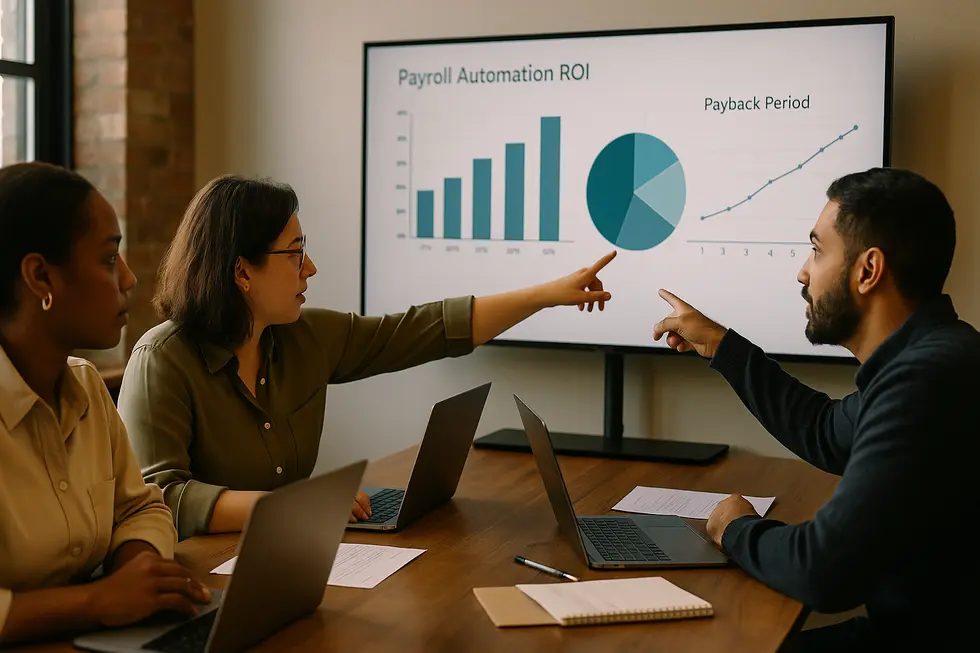Chapter 1 — 9 Financial Metrics CFOs Need to Measure Payroll Automation ROI in SMEs: Why it matters and how to start

1. Chapter 1 — 9 Financial Metrics CFOs Need to Measure Payroll Automation ROI in SMEs: Why it matters and how to start — Baseline & Quick Wins
Snapshot your baseline: total payroll hours, external fees, correction costs, cycle time, and pay-related complaints. That snapshot turns opinion into measure. Convert hours to fully loaded dollars and record those figures as your control.
Run a 90-day pilot on one pay group and track the nine metrics monthly. Look for quick wins—automated tax calculations, single-source HR→pay feeds, and auto-reconciliations—that cut manual corrections fast. Example: a 50-person SME saving 20 payroll hours/month can reassign that time to higher-value finance tasks.
Track errors and compliance avoided as dollar line-items. Use conservative assumptions for turnover impact and re-measure at six and twelve months to capture steady-state benefits. For a practical checklist, see AIHR.
2. Chapter 1 — 9 Financial Metrics CFOs Need to Measure Payroll Automation ROI in SMEs: Why it matters and how to start — Measuring Cost, Time, and Error Reduction
Who knows the true cost of payroll mistakes at your firm? Start with three measurable lenses: cost, time, and errors. Convert processing hours into fully loaded dollars to expose direct payroll labor cost. Track overtime and ad-hoc spend for rush fixes. Measure cycle time in days and watch how automation compresses it. Count errors per 1,000 pays and attach a dollar remediation cost to each. Don’t forget TCO: licenses, integrations, training, and support. Turn hours saved into administrative FTEs freed to show redeployable capacity. A practical anchor: a 180-person services firm cut corrections from 50 to 5 monthly, funding one salary and improving hiring work. For implementation ideas visit HR Tech Partner.
3. Chapter 1 — 9 Financial Metrics CFOs Need to Measure Payroll Automation ROI in SMEs: Why it matters and how to start — Compliance, Integration, and Risk Avoidance
Payroll sits at the intersection of cost, compliance, and risk. Automating it closes common leak points: misclassifications, manual corrections, and messy reconciliations. What does that save? Avoided fines, fewer audit hours, and steadier cash forecasting. Start simple: baseline error rates, reconciliation hours, penalty occurrences, and time-to-close reports for two to three cycles. Tie those to dollar values—expected fines, hourly remediation cost, and treasury float. Watch integrations: a stalled bank feed can create costly delays. Small firms often miss these line items. Track them monthly and report to FP&A. For implementation tips and vendor-agnostic perspectives, see HR Tech Central.
Even a single prevented penalty pays for most pilots. Use 90-day pilots to isolate effects and build a clear narrative for the board.
Chapter 1 — 9 Financial Metrics CFOs Need to Measure Payroll Automation ROI in SMEs: Why it matters and how to start

1. Employee Experience, Turnover, and Revenue Impact
Who feels payroll more than anyone? Every employee. A single mispay damages trust. Track payroll error rate, processing time, time-to-resolve queries, and exits clearly tied to payroll. Then ask: what is our revenue per FTE and how much does each retained employee contribute? Convert fewer errors and faster resolution into avoided hiring costs and preserved revenue. Start with a simple baseline and a 90-day pilot. Small wins matter: imagine reducing corrections from 50 to 5 and freeing one FTE. Use conservative estimates, sum labor and retention benefits, then divide by investment to get payback. For practical analytics tips, see AIHR.
2. Chapter 2 — 9 Financial Metrics CFOs Need to Measure Payroll Automation ROI in SMEs: Adoption and Implementation Roadmap
How will you prove payroll automation paid off? Start by locking a clear baseline for the nine finance-first KPIs and map each to dollars or hours. Run a 90-day pilot on one or two pay groups. Track pre/post values for labor hours, error counts, vendor fees, and cash timing. Convert reclaimed hours into fully-loaded salary dollars. Use conservative assumptions for turnover and soft benefits. Invest in training, document controls, and pick tools with APIs to cut reconciliation time. Build a simple dashboard and re-run models quarterly. Short cycles and clear baselines turn vendor claims into a CFO-validated ROI story. AIHR guide
3. Chapter 2 — 9 Financial Metrics CFOs Need to Measure Payroll Automation ROI in SMEs: Calculating ROI & Payback with Examples
How fast will payroll automation pay back? Start with a clear checklist: total investment (implementation plus recurring fees) and annual benefits. Count hours saved and multiply by fully loaded rates. Add fines avoided, fewer corrections, and turnover savings tied to payroll accuracy. Calculate ROI = Net Benefit ÷ Investment × 100 and Payback = Investment ÷ Annual Net Benefit. Run a 90-day pilot to capture baseline monthly hours, corrections, late-pay incidents, and churn linked to payroll. Do ±20% sensitivity tests. Example: a $50,000 project with $15,000 annual savings yields ~3.3 years payback and 50% five-year ROI. Report the numbers and the story together for the board. For practical HR analytics pointers see AIHR.
Chapter 2 — 9 Financial Metrics CFOs Need to Measure Payroll Automation ROI in SMEs: The nine metrics explained with practical examples

1. Chapter 2 — 9 Financial Metrics CFOs Need to Measure Payroll Automation ROI in SMEs: Employee Experience, Accuracy & Turnover Impacts
How do you turn payroll accuracy into measurable savings? Start by linking three things: reduced errors, faster pay, and happier people. Track payroll FTE hours saved and error-rate drops. Measure a simple payroll NPS or a two-question pulse and watch self-service adoption. Convert fewer mistakes into dollars: remediation hours, avoided fines, and the replacement cost saved when fewer people leave. Small changes compound — a single avoided hire can cover months of subscription fees. Remember the 180-person firm that cut corrections from ~50 to 5 and effectively funded a new benefits lead. Use conservative estimates. Run a 90-day baseline and report results to the CFO monthly. HR tech partner insights
Further reading: https://www.aihr.com/
2. Chapter 2 — 9 Financial Metrics CFOs Need to Measure Payroll Automation ROI in SMEs: Compliance, Risk Reduction, and Ongoing Measurement
Want proof beyond the sticker price? Payroll automation pays in fewer mistakes, less risk, and time you can redeploy. Start with a baseline and a simple dashboard. Track ROI/payback, cost per payroll transaction, FTE hours reclaimed, error rate and cost of errors, and compliance outcomes. Add a payroll-specific satisfaction score to flag hidden turnover costs. Review monthly for the first year, then quarterly. Use a 90-day pilot to isolate impact and set conservative values for intangibles. Ask weekly: are penalties down? Are manual steps falling? Are managers getting timely reports? Small, repeatable measures make the finance case clear and actionable. An SME example: a 180-person firm cut manual corrections from 50 to 5, freeing one FTE to lead benefits work.
3. Chapter 3 — 9 Financial Metrics CFOs Need to Measure Payroll Automation ROI in SMEs: SME implementation playbook (pilot, data, attribution) — Pilot design & baseline metrics
Start small and measure precisely. Design a pilot around one business unit, payroll cycle, or employee type to limit variables. Set two or three clear objectives — cut processing hours, reduce errors, shorten cycle time. Form a cross-functional steering team (CFO, HR lead, payroll admin, IT). Run the pilot for at least two to three consecutive pay cycles to capture steady-state behavior.
Capture baselines: labor hours per cycle, cost per payslip, error rate, processing time, compliance incidents, overtime, and payroll satisfaction. Use time tracking, system logs, error tickets, and short surveys. Use a control group or phased rollout to isolate effects. Define success thresholds and the payback formula up front (payback = investment / monthly net savings). Log external events and use conservative assumptions so your ROI stands up to scrutiny. For practical tips see HR Tech Central. Further reading: AIHR
Chapter 3 — 9 Financial Metrics CFOs Need to Measure Payroll Automation ROI in SMEs: SME implementation playbook (pilot, data, attribution)

1. Tracking the 9 Financial Metrics: Clear Definitions & Simple Calculations for Your Pilot
How do you prove payroll automation pays? Start with a 90-day pilot, capture a clean baseline, and document assumptions. Track each metric with a simple formula. Total labor cost saved = (pre hours − post hours) × fully‑loaded hourly rate. Cost per payroll transaction = total payroll ops cost ÷ number of transactions. Error‑rate reduction = (error rate pre − post) ÷ pre. Payroll cycle time saved = days reduced × payroll team cost/day. Convert hours saved to FTEs by dividing by standard FTE hours. Employee experience converts to avoided turnover cost using a conservative percentage. ROI = (cumulative benefits − total automation costs) ÷ total automation costs; payback months = total cost ÷ monthly net benefit. Attribute only gains aligned to automation and re‑measure at 6 and 12 months.
2. Attribution methods & quick ROI modelling
How do you prove payroll automation caused the change — not something else? Start with a short pilot and a control group. Run automation in one pay group and leave a similar group manual. Compare pre/post results and use difference-in-differences to strip out company trends. When pilots aren’t possible, compare baseline trend lines to post-launch performance and exclude known confounders like headcount swings or policy changes. Combine hard numbers (hours, errors, penalties avoided) with manager sign-offs or short surveys. For ROI, keep it simple: list costs (one-time + annual), recurring savings, and payback. Show conservative/base/optimistic scenarios and a ±20% sensitivity. Lock sources, document assumptions, and present the story clearly. See HR analysis perspectives at HR Tech Central.
3. Chapter 3 — 9 Financial Metrics CFOs Need to Measure Payroll Automation ROI in SMEs: SME implementation playbook (pilot, data, attribution) — Scaling, governance & change management
Scaling payroll automation is a sequence, not a leap. Start with a tight pilot, prove causality with time-motion logs and a control group, then expand. Which numbers matter most? The nine metrics give you the ledger, but governance and people change lock in value. Lock down data access, standardize payroll rules, and set KPIs that tie to the P&L. Create a small governance committee to review exceptions weekly. Train payroll and HR, publish clear SLAs, and celebrate early wins to reduce change fatigue. Keep the business case live—update ROI and payback as headcount and rules evolve. For practical frameworks see HRTechPartner insights. Further reading: AIHR.
Final thoughts
Payroll automation is persuasive when you translate process improvements into financial terms a CFO understands. Start by capturing a clean baseline for costs, hours and errors over a representative period, then convert saved hours and avoided penalties into dollars using fully loaded rates. Link productivity gains to specific outcomes — faster closes, better billing or improved recruitment — so the business impact is clear and repeatable. Be realistic about implementation effort: integrations, data cleanup and testing matter, and project hours should be included in the investment side. Re-measure at 3, 6 and 12 months and present a simple ROI and payback calculation; even a single avoided tax penalty or a measurable drop in payroll corrections can change the business case. Finally, tell a compact story: what did you stop doing, who got time back, and what did they now do that drives value? That narrative, supported by nine practical metrics, turns payroll automation from an IT request into a board-level investment.
Book a 30-min discovery call to map your payroll baseline and build a CFO-ready ROI case tailored to your business.
About us
HR Tech Partner helps small and mid-size companies digitise HR. From HRIS selection and payroll automation to integration and change-management coaching, our consultants turn fragmented processes into one agile, data-driven ecosystem—so HR teams spend less time on admin and more time on people.









